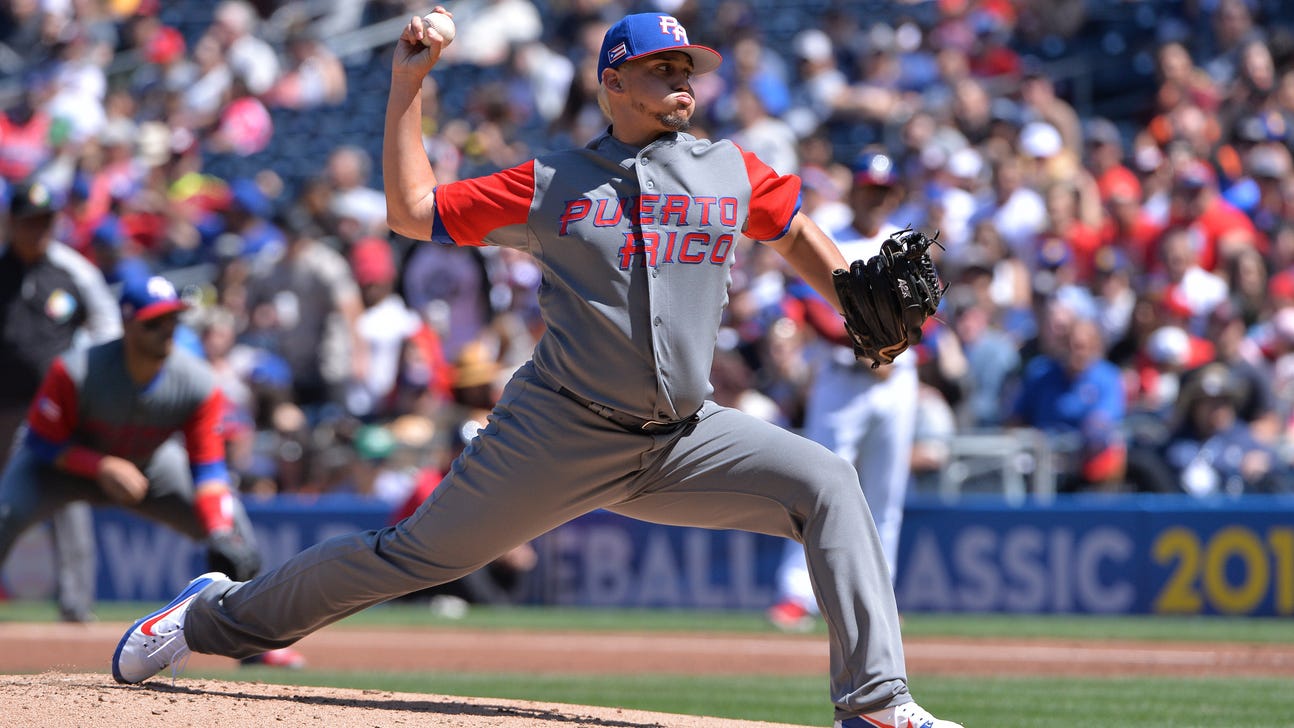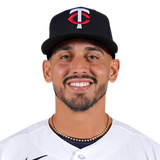
Tampa Bay Rays Scouting Report On RHP Jose De Leon
Mar 18, 2017; San Diego, CA, USA; Puerto Rico pitcher Jose De Leon (87) delivers a pitch during the first inning against Venezuela during the 2017 World Baseball Classic at Petco Park. Mandatory Credit: Orlando Ramirez-USA TODAY Sports
Tampa Bay Rays right Jose De Leon made his first appearance of the minor league season this week. What did the Rays acquire in the young right-hander?
Player Profile
The Tampa Bay Rays acquired Jose De Leon this offseason from the Los Angeles Dodgers.
A native of Puerto Rico, Jose De Leon was drafted by the Dodgers in 24th round of the 2013 draft after three seasons at Southern University and A&M College.
De Leon opened with the Arizona Rookie League after his draft before finishing with a disastrous time at Ogden in the Pioneer League. Overall, he posted a 6.96 ERA over 14 games, 13 of them starts, throwing 53 innings, with a 1.66 WHIP, 8.4% walk rate, and a 21.2% strikeout rate.
De Leon spent time in extended spring before returning to Ogden in 2014. The return trip was much kinder to him, as was his last season promotion to low-A Great Lakes in the Midwest League.
Overall, he made 14 appearances, 12 of them starts, throwing 77 innings with a 2.22 ERA, 1.03 WHIP, 6.69% walk rate, and striking out an incredible 37.9% of batters he faced on the season!
In spite of just 4 starts at low-A, the Dodgers felt comfortable moving De Leon to high-A to open 2015. He didn't last long there, either, moving up to AA in the Texas League with Tulsa.
Combined, De Leon made 23 starts, putting up a 2.99 ERA over 114 1/3 innings with a 1.09 WHIP, 7.96% walk rate, and 35.05% strikeout rate.
While one big season could be put off, his second season was too much to be ignored by prospect folks, and De Leon took a big jump up prospect lists, ranking #23 in the Baseball America top 100 list, #24 in MLB Pipeline's list, and #28 in Baseball Prospectus' list.
De Leon got a taste of the Pacific Coast League in 2016, but he didn't struggle with the noted hitter's haven, posting a 2.61 ERA over 16 starts and 86 1/3 innings with a 0.94 WHIP, 5.85% walk rate, and 32.46% strikeout rate.
The Dodgers gave De Leon a major league trial last September, and it didn't go so well, as he posted a 6.35 ERA over 4 starts, throwing 17 innings with a 1.53 WHIP, 8.75% walk rate, and 18.75% strikeout rate.
After the season, ranking services were a bit down on De Leon due to his age as a prospect and the struggles in his first taste of major league ball, seeing him drop to #29 on list, #33 on MLB's list, and #38 on BP's list. He was rated #23 overall in the Call To The Pen Top 125 prospects in January.
In January 2017, the Dodgers traded De Leon to the Tampa Bay Rays for second baseman Logan Forsythe.
On Thursday, May 11th, De Leon made his debut in the Rays system after opening the season on the DL. He made a minor league rehab start for Charlotte in the Florida State League, going 3 1/3 innings, allowing 2 runs on 5 hits, walking none, and striking out 7.
Scouting Report
Size/Delivery/Control
Size – De Leon is listed at 6'2″ tall and 190 pounds, and that weight could even be stretching it. He is long and lean, with surprisingly long limbs for a guy at 6'2.
Delivery – De Leon's delivery is fairly easy with a leg lift a touch past the waist as he squares his front left shoulder to nearly a perfect perpendicular to home plate.
He takes a long stride toward the plate and comes to the plate with a 3/4 delivery that has both the arm appearance of low 3/4 and high 3/4 both due to the arm position when De Leon begins his pull back of the ball from his glove to a follow through in high 3/4 position, but the ball actually releases from the natural 3/4 position.
Whether this unique arm motion has led to his shoulder issues in his career is beyond my personal medical expertise, but it's certainly something I could see causing extra stress in the shoulder and obliques in the way he has to work his body in order to make that arm motion work.
He is consistent with the delivery and release point, and it is to be noted that this arm motion has been cited by lefty hitters as a way for him to have a level of deception to his pitches.
Control (55) – While De Leon has been noted for plus control in the past, what I noted in watching him is that while he had solid control in keeping the ball in the zone, De Leon frequently missed his catcher's target, and that really hurt him in the major leagues in the games I watched of his at the big league level.
More from Call to the Pen
Pitches
Fastball (60) – Most guys with a "plus" fastball are known for their big velocity, but De Leon has a fastball that sits around 91-93, touching 95-96 at its best.
What makes the pitch so excellent is the ability to manipulate his fastball in multiple ways, as he gets the pitch to sink, cut, and, while he doesn't use the split grip, he even gets some split action on his fastball at times.
One thing he did experience in the move from minors to majors is the change in handling 95 up in the zone as he has the ability to have a rising fastball up in the zone, but it can also hang right in the batter's eye if he doesn't locate it well, and he got pounded in the big leagues on pitches up in the zone.
Change Up (70) – While his fastball moves, De Leon's change up seems to mimic the fastball with additional movement on top of that already notable movement.
The pitch has been considered among the best change ups in all of the minor leagues, and he is able to use it effectively against both righties and lefties.
Slider (50) – De Leon's slider was a pitch that I saw tremendous variance on in 2016. His best slider was easily a plus pitch, maybe even a 65 grade. Yet he had many games where it'd be hard to even put a 40 on the quality of the slider.
When he has the change really working and can manipulate the movement of that pitch, his slider not working well is not a big deal, but for success at the big league level, it will be imperative that he can at least locate the pitch to keep folks honest.
His slider is at its best when he's working the edges of the plate with it just right at or a hair below the knee level. The quick, short bite on the pitch seems to play up best in those locations.
Curve ball (55) – A new pitch in 2016 for De Leon, or more accurately, a slow, loopy version of his slider was inconsistent in the minors, to say the least.
In the majors, that pitch was not hit at all, but he did have a couple of juicy curves that he hung up in the zone too much.
MLB Player Comp
While the builds are not extremely similar, and they even throw with the opposite hands, I cannot help but continually think about Rangers lefty Martin Perez when I watch De Leon play.
Many see where Perez is now after multiple injuries have really turned him into a back end of the rotation starter, but there was a time when Perez was a fairly easy top 25 selection in top prospect lists with plenty of projection as a front line starter before injuries truly sapped his top-end abilities on the mound.
De Leon likely would have a major league floor if he could hold down a rotation spot of what of a back end guy. However, there's legit reason to believe he could use that excellent change among his other changes to truly work as a front line starter.
In general, the Rays would gleam value out of De Leon if they only got Perez's production out of De Leon as Perez has thrown to a 4.26 ERA over 90 games in his career.
De Leon will likely work his way back to the AAA Durham rotation, and though fellow righty Brent Honeywell's early season performance has likely moved him ahead of De Leon on the pecking order of starters, he should be a quick call up as he is already on the 40-man roster.
